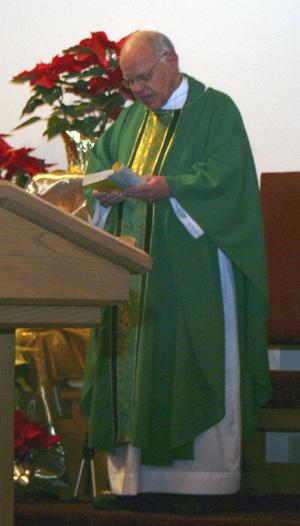
By Deacon Frank Agnoli
Besides the private prayers of the priest and deacon before and after the reading of the Gospel, we won’t see much of a change at all during the Liturgy of the Word — except when it comes to the Creeds.
The first thing that we’ll notice with the Nicene Creed is that, like the Apostles’ Creed, it will be in the singular. As I mentioned in a previous letter to the editor, the original Greek of the Creed — as first promulgated at Nicaea (AD 325) and reissued, with minor changes, at Constantinople (AD 381) — is in the plural. Liturgical use of the Creed in both Byzantine East and Roman West, however, has preferred the singular form — in Latin, credo. The singular reflects baptismal usage and echoes the singular of both the older Apostles’ Creed and the interrogatory form of the baptismal profession of faith (answering “I do” to the questions posed by the minister). When the Creed was imported into the Eucharistic liturgy (end of the sixth century in Spain, not until the 11th century in Rome), the singular was maintained.
When the text was translated after Vatican II, although the Latin was in the singular, the plural was used in English; other language groups kept the singular. With the new translation, we will not only share a closer translation with Catholics of other language groups around the world but we will also return to the traditional liturgical usage of the Creed.
In addition, St. Thomas Aquinas — who only knew of the Creed in its singular form — argued that the “I” in the Creed is the church, what we would call today the body of Christ. Interestingly, therefore, the use of the first-person singular both highlights personal responsibility (we renew our baptismal faith) as well as communal identity and oneness in belief.
Second, rather than a series of paragraphs beginning with, “we believe,” the various components of the Creed are connected with “and.” This construct reminds us that the Creed is a whole, not a collection of individual and isolated beliefs.
Third, the vocabulary is more theologically precise: words like “consubstantial” and “incarnate” are used.
“Consubstantial” is a difficult word to wrap our heads around. The original Greek is homoousios, a word made up of two roots: homo + ousia. Homo is the Greek root signifying sameness. Ousia is a more technical word, referring to the essence or heart or most real aspect of something. The Greek was translated into Latin as consubstantialis, which gives us the English, “consubstantial.” For those interested in more detail, please see the explanation given on the U.S. bishops’ Web site: http://www.usccb.org/romanmissal/consubstantial.shtml. The bottom line is that no word can capture the mystery of the Trinity, and perhaps by using “consubstantial” we’ll be reminded that, in the end, the inner life of God is beyond our language and comprehension.
Using the phrase “incarnate of the Virgin Mary” makes two important points. First, it highlights the fact that Jesus’ human flesh came from Mary; he was not just “born” from her but was knit in her womb. Second, this phrase connects to the earlier claim in the Creed that Christ was “born of the Father before all ages.” This provocative phrase reminds me of the way that the church has referred to Christ as being eternally begotten from the “womb of the Father.” Even the Greek of John1:18 that we render as “heart” (or “bosom” or “side”) is literally “womb.” Clearly, only metaphorical language can approach the infinite mystery of God who transcends gender!
(Deacon Agnoli is director of liturgy for the Diocese of Davenport.)
Present Text of Nicene Creed
We believe in one God,
the Father, the Almighty,
maker of heaven and earth,
of all that is seen and unseen.
We believe in one Lord, Jesus Christ,
the only Son of God,
eternally begotten of the Father,
God from God, Light from Light,
true God from true God,
begotten, not made,
one in Being with the Father.
Through him all things were made.
For us men and for our salvation
he came down from heaven:
by the power of the Holy Spirit
he was born of the Virgin Mary,
and became man.
For our sake
he was crucified under Pontius Pilate;
he suffered, died, and was buried.
On the third day he rose again
in fulfillment of the Scriptures;
he ascended into heaven and is seated
at the right hand of the Father.
He will come again in glory
to judge the living and the dead,
and his kingdom will have no end.
We believe in the Holy Spirit,
the Lord, the giver of life, who proceeds
from the Father and the Son.
With the Father and the Son
he is worshipped and glorified.
He has spoken through the Prophets.
We believe in one holy catholic
and apostolic Church.
We acknowledge one baptism
for the forgiveness of sins.
We look for the resurrection
of the dead,
and the life of the world to come. Amen.
New Text
I believe in one God,
the Father almighty,
maker of heaven and earth,
of all things visible and invisible.
And in one Lord Jesus Christ,
the Only Begotten Son of God,
born of the Father before all ages.
God from God, Light from Light,
true God from true God,
begotten, not made,
consubstantial with the Father;
through him all things were made.
For us men and for our salvation
he came down from heaven,
and by the Holy Spirit
was incarnate of the Virgin Mary,
and became man.
For our sake
he was crucified under Pontius Pilate,
he suffered death and was buried,
and rose again on the third day
in accordance with the Scriptures.
He ascended into heaven and is seated
at the right hand of the Father.
He will come again in glory
to judge the living and the dead
and his kingdom will have no end.
And in the Holy Spirit, the Lord,
the giver of life, who proceeds
from the Father and the Son,
who with the Father and the Son
is adored and glorified,
who has spoken through the prophets.
And one, holy, catholic
and apostolic Church.
I confess one baptism
for the forgiveness of sins
and I look forward to the resurrection
of the dead
and the life of the world to come. Amen.








